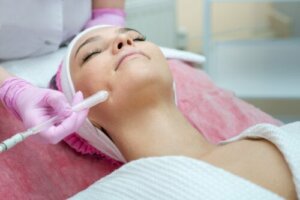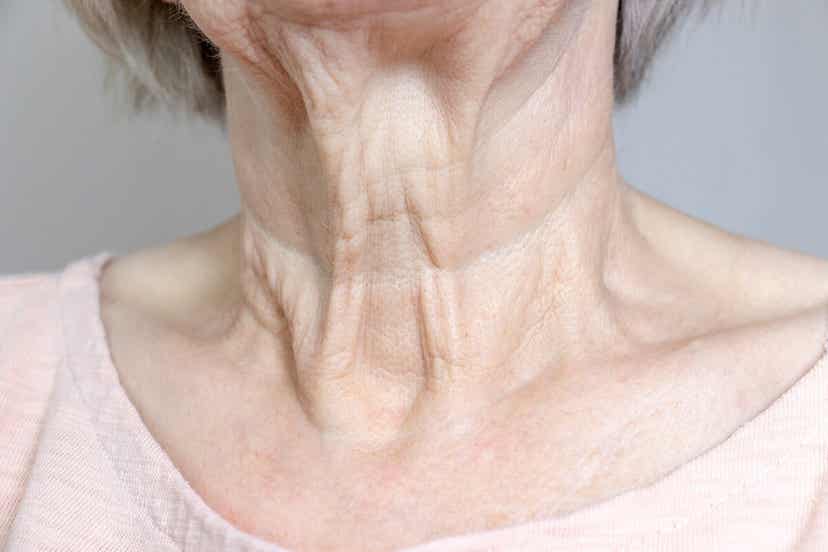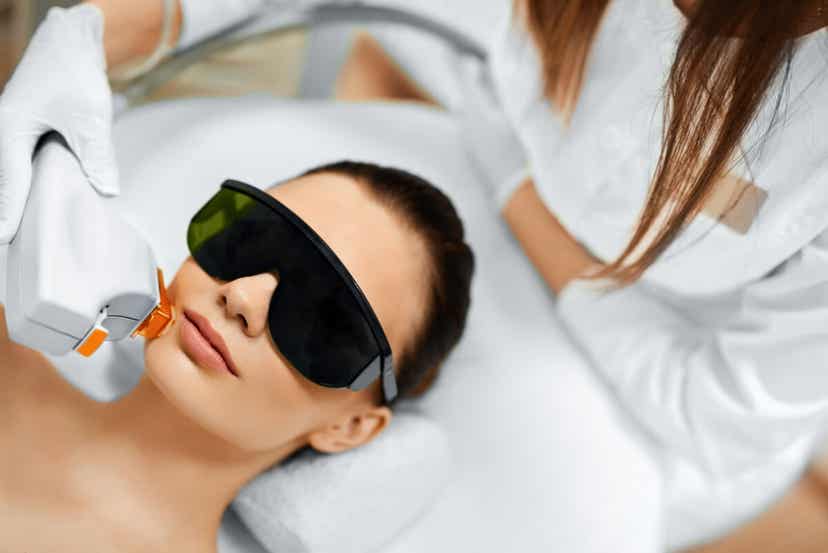What's a Jet Peel Facial and What Are Its Benefits?

The jet peel is a novel technology developed for aesthetic purposes. As such, it’s part of what we call anti-aging treatments. Its purpose is to help combat the signs of aging, as well as dryness and other problems, including acne.
During jet peel treatments, high-pressure air currents are used to penetrate the dermis. This allows the introduction of liquids with products that can help cleanse and regenerate the skin.
It’s a minimally invasive procedure. Due to its advantages and benefits, it’s widely accepted and has gained much popularity in recent years.
How does the jet peel facial work?
Before starting the jet peel, a professional cleanses the skin using pressurized oxygen and saline water. Then, they apply a high-pressure air jet by means of a device that penetrates the dermis.
This in turn allows the introduction of different products, which are cleansers and nutrients. For this purpose, professionals use a customized serum according to the needs of the person receiving the treatment.
This serum may contain substances such as the following:
- Aloe vera
- Sodium lactate
- Salicylic, glycolic, mandelic, or hyaluronic acids
- Vitamins C and B complex
- Lemon balm
- Achillea
Be sure to read: Egg Face Mask to Cleanse and Tighten Skin
What are the benefits of a jet peel?
The jet peel is primarily a procedure for aesthetic purposes. It’s safe for those with sensitive skin as well as those with skin conditions, providing several benefits.
Anti-aging
According to experts, jet peel facials stimulate the production of collagen and elastin. The dermis is composed of collagen, which provides structure and elasticity. But the low production of this substance is what causes the skin to age.
With this in mind, the jet peel gives volume and firmness to the skin, helping to reduce the signs of aging. This applies to wrinkles and blemishes, as well as the effects of the sun.

Exfoliation and cleansing
The procedure cleans out dirt and products that have accumulated in the pores. In addition, jet peel exfoliation may minimize scarring by smoothing and refreshing the skin. It even helps to make your skin tone more even, even when it comes to dark circles under your eyes.
Other uses and benefits
The benefits of jet peel technology may go beyond aesthetics. Although there’s not much research on the subject yes, studies have found that it may have other potential uses:
- For baldness: According to one study, jet peel technology allows for more efficient delivery of products such as minoxidil to people’s scalps more efficiently.
- Another study found that jet peel may be useful in delivering local anesthesia.
Continue reading about: Peels and the removal of dead cells
The side effects and contraindications of jet peel facials
Experts believe exfoliation with jet peel technology to be quite safe, as long as the procedure takes place in the correct manner and using the proper implements. However, there’s always the possibility of reactions and side effects:
- Infectious cellulitis: Although these cases are rare.
- Signs of redness, which usually disappear within hours.
- There have also been reports of swelling in the treated area.
- While the procedure’s supposedly painless, there may be sensitivity afterward.
- When glycolic acid’s used, there’s some skin peeling in the days following the treatment.
Jet peel isn’t recommended for pregnant women. The effect of some components of the serums may be on the gestation process have yet to be thoroughly researched.
How long do the effects of the jet peel last?
The results of the peel are temporary, as they only last up to one month. However, this can vary from person to person.
Particularly, when it comes to first-time users, it’s best to repeat the procedure once a week for at least three weeks. This is followed by monthly maintenance.
At the same time, there’s no need for a recovery period and no need to rest. However, makeup should be avoided within six hours after treatment to ensure that the serums have time to be absorbed into the skin.
How is it different from other exfoliation methods?
Exfoliating the skin is something that’s done for deep cleansing. Jet peel facials are used for such purposes. There are other exfoliation procedures that exist as well, and we’ll look at the differences below.
Microdermabrasion
Microdermabrasion uses a diamond-tipped applicator to remove dead skin cells. It’s useful in the treatment of blemishes, fighting wrinkles, and stimulating the production of collagen and elastin, thus helping to keep the skin firm.
In both procedures, the skin is exfoliated and the signs of aging and scars are reduced. However, microdermabrasion is more superficial, while jet peel reaches the dermis.
Radiofrequency
Radiofrequency uses heat waves to stimulate collagen production and diminish the effects of aging on the skin. Like jet peel, radiofrequency is minimally invasive and acts on the deep layer of the skin.
The difference lies in the type of technology used, which has an impact on the cost. In this sense, radiofrequency treatments can be more expensive.

Hydrafacial and dermal infusion in jet peel treatments
Dermalinfusion also uses a diamond-tipped instrument while exfoliating, vacuuming debris, and introducing serum into the skin. In this way, it’s similar to jet peel. Both are minimally invasive procedures.
A similar technique is the hydrafacial, which also exfoliates, cleanses, and removes dead cells and impurities. At the same time, a cocktail with hyaluronic acid, peptides, and antioxidants is applied.
These treatments have similar characteristics and results. However, there’s no research to claim that any of them is superior to the others.
Clean skin inside and out
Jet peel is a non-invasive, safe procedure with few side reactions. It’s said to be quite effective, with effects that are noticeable almost immediately. What’s more, it’s approved by the Food and Drugs Administration (FDA).
However, besides its use or any other aesthetic procedure with the same purposes, it’s important to take into account other measures, recommendations, and tips to maintain healthy skin. This includes proper nutrition, hydration, and protection from external factors, such as excessive sun exposure.
All cited sources were thoroughly reviewed by our team to ensure their quality, reliability, currency, and validity. The bibliography of this article was considered reliable and of academic or scientific accuracy.
- Apt P, Saavedra D, Waissbluth M, Rejuvenecimiento no ablativo. Revista Médica Clínica Las Condes. 2010; 21(1): 87-96.
- Brody H, Monheit G, Resnik S, Thomas A. A History of Chemical Peeling Dermatologic Surgery. 2000; 26(5): 405-409.
- Combalia A. Piel sana in corpore sano: Consejos prácticos para tener una piel sana. Barcelona: Grijalbo.
- Drake L, Dinehart S, Goltz R, et al. Guidelines of care for chemical peeling. J Am Acad Dermatol. 1995; 33: 497-503.
- Mene R. Melasma: Tratamiento con Yellow Peel. Med Estetica. 5(5): 23-25.
- Murad H, Shamban A, Scott P. The use of glycolic acid as a peeling agent. Dermatol Clin. 1995;13: 285-307.
- Skroza N, Proietti I, Potenza C, Dessy L. Mechanic Resurfacing, Needling, Dermoabrasion and Microdermoabrasion. In: Scuderi N., Toth B. (eds) International Textbook of Aesthetic Surgery. Springer, Berlin, Heidelberg, 2016.
This text is provided for informational purposes only and does not replace consultation with a professional. If in doubt, consult your specialist.








